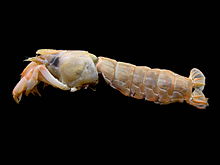
The Caridea, commonly known as caridean shrimp or true shrimp, are an infraorder of shrimp within the order Decapoda. This infraorder contains all species of true shrimp. They are found widely around the world in both fresh and salt water. Many other animals with similar names – such as the mud shrimp of Axiidea and the boxer shrimp of Stenopodidea – are not true shrimp, but many have evolved features similar to true shrimp.

The Decapoda or decapods are an order of crustaceans within the class Malacostraca, including many familiar groups, such as crabs, lobsters, crayfish, shrimp, and prawns. Most decapods are scavengers. The order is estimated to contain nearly 15,000 species in around 2,700 genera, with around 3,300 fossil species. Nearly half of these species are crabs, with the shrimp and Anomura including hermit crabs, porcelain crabs, squat lobsters making up the bulk of the remainder. The earliest fossil decapod is the Devonian Palaeopalaemon.
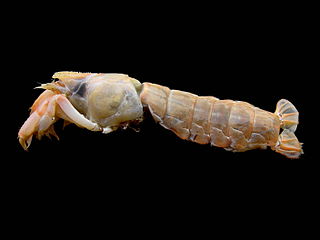
Thalassinidea is a former infraorder of decapod crustaceans that live in burrows in muddy bottoms of the world's oceans. In Australian English, the littoral thalassinidean Trypaea australiensis is referred to as the yabby, frequently used as bait for estuarine fishing; elsewhere, however, they are poorly known, and as such have few vernacular names, "mud lobster" and "ghost shrimp" counting among them. The burrows made by thalassinideans are frequently preserved, and the fossil record of thalassinideans reaches back to the late Jurassic.
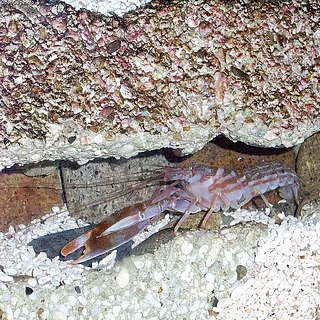
Alpheidae is a family of caridean snapping shrimp, characterized by having asymmetrical claws, the larger of which is typically capable of producing a loud snapping sound. Other common names for animals in the group are pistol shrimp or alpheid shrimp.

Axiidea is an infraorder of decapod crustaceans. They are colloquially known as mud shrimp, ghost shrimp, or burrowing shrimp; however, these decapods are only distantly related to true shrimp. Axiidea and Gebiidea are divergent infraoders of the former infraorder Thalassinidea. These infraorders have converged ecologically and morphologically as burrowing forms. Based on molecular evidence as of 2009, it is now widely believed that these two infraorders represent two distinct lineages separate from one another. Since this is a recent change, much of the literature and research surrounding these infraorders still refers to the Axiidea and Gebiidea in combination as "thalassinidean" for the sake of clarity and reference. This division based on molecular evidence is consistent with the groupings proposed by Robert Gurney in 1938 based on larval developmental stages.

Upogebia is a genus of mud shrimp, in the family Upogebiidae, containing the following species:
Acutigebia danai is a mud shrimp of the family Upogebiidae, endemic to the coastal waters of New Zealand and the Kermadec Islands.
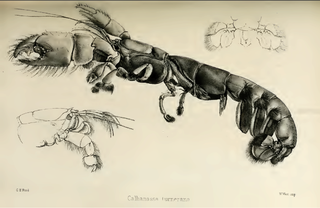
Callianassa is a genus of mud shrimps, in the family Callianassidae. Three of the species in this genus have been split off into a new genus, Pestarella, while others such as Callianassa filholi have been moved to Biffarius.
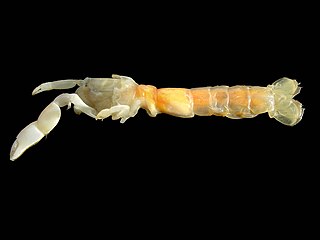
Gilvossius tyrrhenus is a species of thalassinidean crustacean which grows to a length of 70 mm (2.8 in). It lives in burrows in shallow sandy parts of the sea-bed in the Mediterranean Sea and northern Atlantic Ocean. It is the most common thalassinidean in the Mediterranean, and has been used as bait by fishermen for at least 200 years.

Thalassina is a genus of mud lobsters found in the mangrove swamps of the Indian Ocean and western Pacific Ocean. Its nocturnal burrowing is important for the recycling of nutrients in the mangrove ecosystem, although it is sometimes considered a pest of fish and prawn farms.

Upogebia deltaura is a species of mud lobster from the Atlantic Ocean and Mediterranean Sea.

Latreilliidae is a small family of crabs. They are relatively small, long-legged crabs found on soft bottoms at depths of up 700 metres (2,300 ft) in mostly tropical and subtemperate waters around the world. Their carapace is very small and doesn’t cover the bases of their legs, which protrude from the cephalothorax in a spider-like manner. The family and its type genus are named after Pierre André Latreille. The oldest known fossils from the Latreillidae have been dated to the middle of the Cretaceous period. It comprises seven extant species.

Neotrypaea californiensis, the Bay ghost shrimp, is a species of ghost shrimp that lives on the Pacific coast of North America. It is a pale animal which grows to a length of 11.5 cm (4.5 in). One claw is bigger than the other, especially in males, and the enlarged claw is thought to have a function in mating. N. californiensis is a deposit feeder that lives in extensive burrow systems, and is responsible for high rates of bioturbation. It adversely affects oyster farms, and its numbers are controlled in some places by the application of pesticides. It carries out an important role in the ecosystem, and is used by fishermen as bait.
Biffarius is a genus of ghost shrimp in the family Callianassidae, containing species formerly included in the genus Callianassa. Its members are small and generally live in the intertidal zone. In April 2020, a new species was described from the northeastern Brazilian coast. Biffarius was named in honour of Thomas A. Biffar, and includes the following species:

Crustaceans may pass through a number of larval and immature stages between hatching from their eggs and reaching their adult form. Each of the stages is separated by a moult, in which the hard exoskeleton is shed to allow the animal to grow. The larvae of crustaceans often bear little resemblance to the adult, and there are still cases where it is not known what larvae will grow into what adults. This is especially true of crustaceans which live as benthic adults, more-so than where the larvae are planktonic, and thereby easily caught.

Lepidophthalmus turneranus, the Cameroon ghost shrimp, is a species of "ghost shrimp" or "mud lobster" that lives off the coast of West Africa. It occasionally erupts into dense swarms, one of which resulted in the naming of the country Cameroon.

Acanthaxius is a genus of mud lobster native to the Indo-Pacific oceans. It has a slender rostrum which is longer than the eyestalks, is spinose and has seven spines and has a depth range of 228–438 metres (748–1,437 ft).
Austin Beatty Williams was an American carcinologist, "the acknowledged expert on and leader in studies of the systematics of eastern American decapod crustaceans".

The Pysht Formation is a geologic formation in Washington (state). It preserves fossils dating back to the Paleogene period.
Gourretiidae is a family of crustaceans belonging to the infraorder Axiidea, within the order Decapoda.
